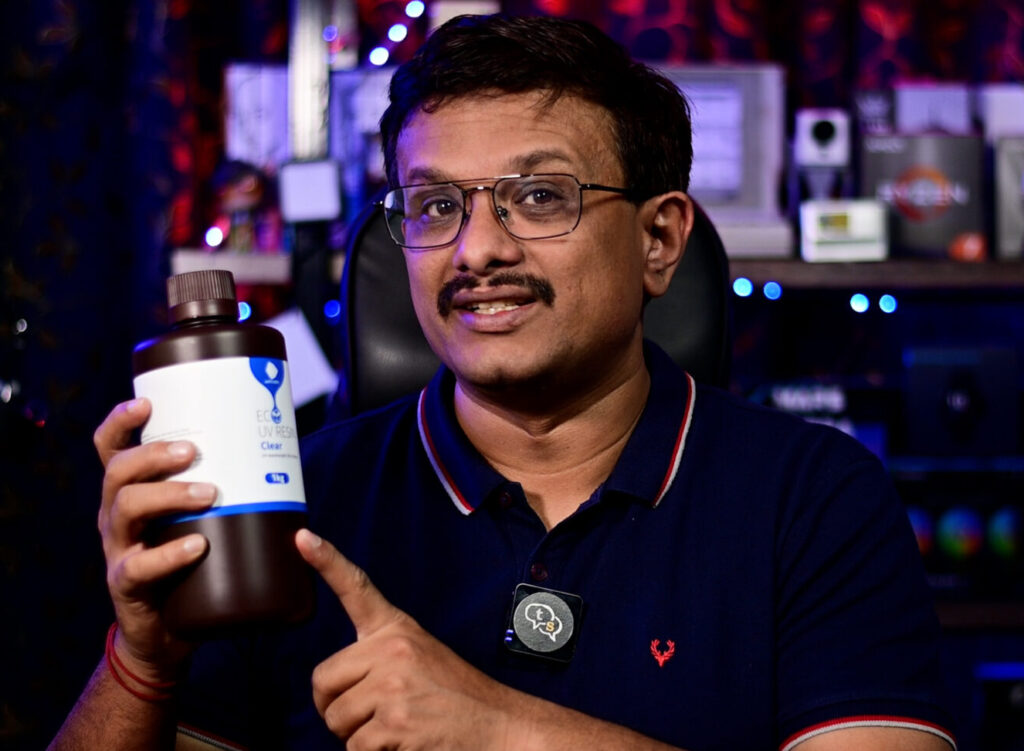I had reviewed the Anycubic photon mono 4K, maybe a year back? The resin I used earlier was by Anycubic and they are petroleum based. These resins stank up my house and my printer was out of commission for a few months due to that.
Until I found out about these, plant based EC UV resin. So how did this change my journey into resin 3d printing, watch on to find out.
SLA printing is a popular choice for high precision and detailed printing. But traditionally, the resin used in SLA printing has been petroleum-based, which is not only harmful to the environment, but also potentially toxic to the user.
This EC UV resin is by Anycubic, and my previous resin was by Anycubic too.
But what’s different here is that this one’s made of soybean, making it more eco-friendly and less stinky. But I needed to put it to the test to make sure, before I recommend the same to you guys. It’s a clear filament, I wanted to see how prints come out using transparent resin.
I’ve read that these resins contain half epoxidized soybean oil and half normal resin chemicals. Since these resins still contain harmful pre-polymers and photo initiators, you should treat them no differently than normal resin.
I’m not using any gloves, but as It’s still resin, you do need to use gloves and maintain all the caution you take with standard resin. Be very careful.
I’ve filled the vat with enough resin for a few prints. So, let’s run the print and we’ll see how it goes.
I kept the settings the same as always, but I always run the base layer for longer to make sure I get good adhesion.
The printer as you can see is active. The room has a smell, but it’s not as strong as standard resin. When standing close to the printer, you can smell the resin, but when I’m close to my computer, It’s barely there.
As the print reaches midway, you can smell the fumes, but still it is much lower than how it used to be.
Being a 4-hour print, the UV light will heat up the resin enough for us to know if it will stink overtime. And I’m really surprised, it’s not bad at all. I can smell it, and the closer you are to the printer, it’s there, but not that bad.
Here’s my print, dumping it straight into isopropyl alcohol to clean.
Here we are, ornamental clefairy, wow look at the details, it’s come out really well.
Here’s a Vulpix.
I’ve also printed miruko from My Hero Academia, as it’s transparent, the details are not visible much. But the print did come out really clean.
All models are downloaded off thingiverse for free.
Made from natural, renewable resources, this resin offers the same high-quality printing results without any of the harmful side effects. It’s supposed to be eco-friendly, not sure about that, but I do know it has a lower odour during printing.
This resin is really cool, now I can print resin prints without the fear of stinking up my room, or even my house. My wife had banned me from using this printer as the fumes gave her and even me headaches. Even when curing the filament, my son complained about the stink as I used his balcony.
This filament doesn’t stink much, and I can barely smell it even though I’m in the same room. Plant based filament costs a bit more than standard filament, but the freedom from the stink that standard resin produces, it’s really a life saver. I can now use my MSLA printer, and have it print in the same room I’m sitting in, which I always wanted to do, because I love the detail you get from resin printers. The best part? The printed objects look just as amazing as they would with petroleum-based resin.
So did this video give you the confidence to pick a MSLA printer for yourself, or have you been using plant-based resin earlier. Make sure to comment below.

